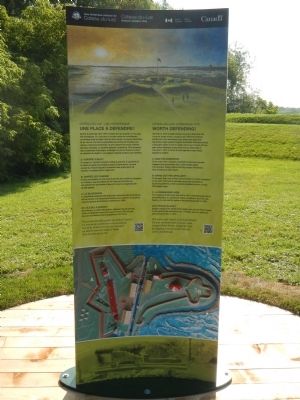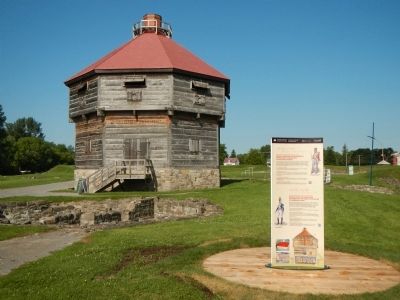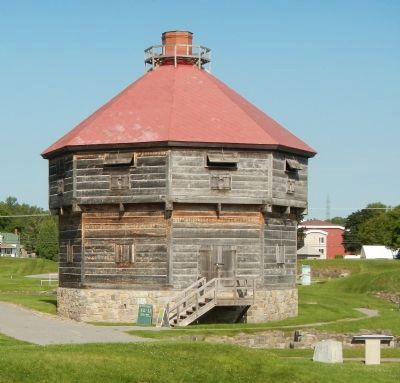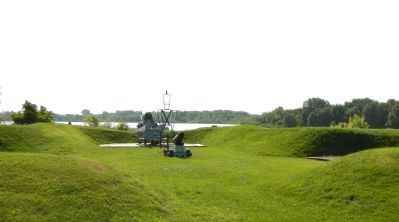Coteau-du-Lac in Vaudreuil-Soulanges, Québec — Central Canada (French-Canadian)
Worth Defending! / Mission: Parry Any Land-based Movements
Une place à défendre! / Mission: Empêcher les mouvements terrestres
Side A:
English:
Coteau-du-Lac: A Strategic Site
The War of 1812 changed Coteau-du-Lac’s defensive role. It was no longer simply a supply post. With the American border just a few kilometres away, their were fears that the enemy might bypass Kingston and attack Montreal directly, cutting the military forces in Upper and Lower Canada off from each other. Defensive works were built on either side of the canal in 1813 to fortify the site against a major attack.
A - Man the Ramparts!
To the west, thick ramparts protected the barracks, powder magazine and guard room from a land-based attack. The ramparts’ design meant that firing angles intersected, thus avoiding any blind spots.
B - Bring out the Artillery!
To the east, there was a three-cannon battery to control navigation on the river. The three 24-pounder guns were mounted on traversing platforms, which could be swivelled to cover a nearly 200-degree angle.
C - A Commanding View
The octagonal blockhouse was built in 1814, overlooking the rest of the fortifications, to counter any attack, overland or from the river. Nearby, you cans see the replica of the blockhouse built in 1969.
And Prison Island?
Straight ahead, in the center of the rapids, you can see Prison Island. It was used to hold prisoners in the 1770-80s, and as a defensive post during the War of 1812.
Have you ever heard of Zadock Steele? He was an American prisoner who escaped from Prison Island in 1782 by digging a tunnel under his cell with a pocketknife.
French:
Coteau-du-lac: Lieu stratégique
Durant la guerre de 1812-1814, Coteau-du-lac acquiert un nouveau rôle stratégique. Ce n’est plus un simple centre de ravitaillement. La frontière avec le États-Unis est alors située à quelques kilomètres, ce qui donne à l’ennemi la possibilité de contourner Kingston pour attaquer directement Montréal, et ainsi séparer les forces militaires des deux Canadas. Le système défensif construit en 1813 comporte deux ensembles d’ouvrages, aménagés de part et d’autre du canal et capables de résister à une attaque majeure soutenue par l’artillerie.
A - Fortifié à Bloc!
À l’ouest, un imposant rempart protège la caserne, la poudrière et le cops de garde d’une attaque depuis la terre ferme. Le tracé dentelé du rempart assure le croisement des angles de tir de manière à ne lasser aucun angle mort.
B - Sortez les canons!
À l’est, un batterie de trois canons permet
de contrôler la navigation sur le fleuve. Les trois pièces de 24 livres sont montées sur des plateformes pivotantes et peuvent couvrir un angle de près de 200 degrés.
C - Le blockhaus
Le blockhaus octogonal (1814) domine l’ensemble des fortifications, afin de contrer une attaque tant terrestre que maritime. À proximité voyez la réplique de blockhaus construite en 1969.
Et l’Île de la Prison?
Droit devant, au milieu des rapides, observez l’île de la Prison. Centre de détention dans les années 1770 et 1780, elle sert de poste de défense durant la guerre de 1812-1814.
Vous avez entendu parler de Zadock Steele? Ce prisonnier américain s’est évadé de l’île de la Prison en 1782 en creusant un tunnel sous sa cellule à l’aide d’un couteau de poche.
Side B:
English:
Military Presence on the Coteau-du-Lac Point
Take a look at the stone foundations, evidence of the many infantry and artillery detachments and militia corps stationed at Coteau-du-Lac during the War of 1812. At least 13 officiers and over 300 soldiers from the 103rd Regiment of Foot has their winter quarters here in 1813-1814, along with 34 women and 26 children. They shared the fort with over
50 soldiers from the Royal Artillery, 33 militiamen from the 5th Battalion and 3 soldiers from the 10th Royal Veterans’ Battalion. Over the course of the war, more than 10,000 people stayed at the Coteau-du-Lac fort.
A - Ah! The Smell of Baking Bread
The bakehouse was built during the war by the British army, to prepare bread for troops stationed at the fort or en route to Upper Canada.
B - From Storehouse to Hospital
The remains to the left of the bakehouse are from one of the storehouses built by the British army during the American War of Independence (1775-1983). It was used to store supplies for Upper Canada Loyalists and military posts on the Great Lakes. The building was converted into a hospital during the War of 1812.
C - A Self-sufficient Building
These stone foundations are from the octagonal blockhouse built by the British army in 1814 to protect the river channel. This type of structure served as an outpost, stopping-off place or barracks for small detachments.
Master Carpenter’s Quarters
The building, erected during the American War of Independence (1775-1783), was used as a hospital and the master carpenter’s quarters during the Independence (sic, War) of 1812. See the remains, not far from the bridge.
French:
Présence militaire à Pointe de Coteau-du-lac
Découvrez les vestiges de maçonnerie qui rappellent la présence à Coteau-du-lac de nombreux détachements d’infanterie et d’artillerie ainsi que de plusieurs corps de miliciens durant la guerre de 1812. Ainsi, en 1813-1814, au moins 13 officiers et plus 300 soldats du 103ᵉ régiment d’infanterie prennent ici leurs quartiers d’hiver, avec 34 femmes et 26 entants. Ils côtoient plus de 50 soldats de l’artillerie royale, 33 miliciens du 5ᵉ bataillon, de même que 3 soldats de 10ᵉ battalion royal des veterans. Durant cette guerre, c’est plus de 10 000 personnes qui ont fréquenté le fort de Coteau-du-lac.
A - Ah! L’odeur du bon pain
C’est à la boulangerie qu’on fabrique le pain pour la garnison et les troupes en transit vers le Haut-Canada. La boulangerie a été construite pendant la guerre par l’armée britannique.
B - D’entrepôt à hôpital!
Le vestige situé à gauche de la boulangerie est celui d’un des entrepôts construits à l’époque de la guerre de l’indépendance américaine (1775-1783) pour abriter les marchandises destinées aux postes militaires des Grands Lacs et par la suite aux Loyalistes du Haut-Canada. L’entrepôt est transformé en hôpital au cours de la guerre de 1812.
C - Une bâtiment autosuffisant
Ces vestiges de maçonnerie sont ceux de blockhaus octogonal de 1814 construit par l’armée britannique pour protéger le chenal fluvial. Ce type de construction servait d’avant-postes, de halte ou de caserne pour les petits détachements.
Le logement du maître-menuisier
Ce bâtiment, construit à l’époque de la guerre de l’indépendance américaine (1775-1783), sert d’hôpital et de logement pour le maître-menuisier durant celle de 1812-1814. Voyez ses vestiges, non loin du pont.
Erected by Parks Canada / Parcs Canada.
Topics. This historical marker is listed in these topic lists: Forts and Castles • War of 1812 • Waterways & Vessels. A significant historical year for this entry is 1812.
Location. 45° 17.251′ N, 74° 10.511′ W. Marker is in Coteau-du-Lac, Québec, in Vaudreuil-Soulanges. Marker can be reached from Chemin du Fleuve close to Rue du Fort, on the left when traveling south. Touch for map. Marker is at or near this postal address: 307 Chemin du Fleuve, Coteau-du-Lac QC J0P 1B0, Canada. Touch for directions.
Other nearby markers. At least 8 other markers are within walking distance of this marker. A strategic site / Un lieu stratégique (a few steps from this marker); A canal that must be preserved (within shouting distance of this marker); Adapting the canal to new needs (within shouting distance of this marker); What is a lock canal? (within shouting distance of this marker); A very busy canal (within shouting distance of this marker); A dry canal (within shouting distance of this marker); The Durham boat (within shouting distance of this marker); A canal excavated in the rock (within shouting distance of this marker). Touch for a list and map of all markers in Coteau-du-Lac.
More about this marker. This marker is located at Coteau-du-Lac National Historic Site.
Credits. This page was last revised on June 16, 2016. It was originally submitted on May 28, 2015, by Barry Swackhamer of Brentwood, California. This page has been viewed 348 times since then and 7 times this year. Photos: 1, 2, 3, 4, 5. submitted on May 28, 2015, by Barry Swackhamer of Brentwood, California. • Andrew Ruppenstein was the editor who published this page.




